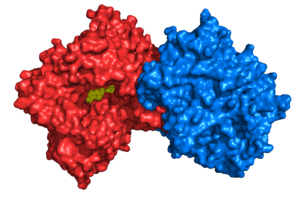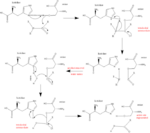Dipeptidyl peptidase IV
From Proteopedia
This page, as it appeared on May 3, 2014, was featured in this article in the journal Biochemistry and Molecular Biology Education.
Contents |
Dipeptidyl Peptidase IV

Introduction
Dipeptidyl Peptidase IV (commonly abbreviated as DPP IV or CD26) is a regulatory protease and binding glycoprotein that carries out numerous functions in humans. DPP IV, discovered by V.K. Hopsu-Havu and G.G. Glenner in homogenized rat liver tissue[1], was originally believed to serve a specific role in breaking 2-Naphthylamine off of Gly-Pro-2-napthylamide, hence its original name glycylproline napthylamidase. However, further research into the specificity of DPP IV showed that it serves a more generic function as a hydrolase (a serine exopeptidase), primarily cleaving N-terminal Xaa-Pro bonds, but also capable of cleaving N-terminal Xaa-Ala bonds. DPP IV is the founding member of the DPP-IV and/or structure homologue (DASH) family, who all share this serine protease catalysis of post-proline peptide bonds. [2] These penultimate prolines of the N-terminus are known for their ability to resist attacks from most proteases and also induce a conformational change in their respective proteins, making DPP IV a unique protease for its ability to cleave this site.[3]
DPP IV also serves as a binding glycoprotein on the membrane of cells, binding ligands such as adenosine deaminase with high affinity.[3] Though this interaction currently has no known significance, DPP IV and its ability to catalyze N-terminal prolines gives it a unique specificity and target for pharmaceutical companies. [1]
Structure
| |||||||||||
Medical Relevancy
DPP IV is found in diverse tissue types and is involved in various biological functions. The activity of DPP IV has been studied in fields like immunology, endocrinology, and the biology of cancers. [3] The ability of DPP IV to inactivate incretins glucagon-like-peptide-1 (GLP-1) and glucose-dependent insulinotropic polypeptide (GIP) have made it a potential drug target for the treatment of Type II Diabetes. GLP-1 and GIP promote glucose uptake, decrease the gastric emptying rate and inhibit glucagon secretion. These actions are all desired when it comes to treating Type II diabetes, but the problem is that DPP IV inactivates GLP-1 and GIP very rapidly (the half-lives of GLP-1 and GIP are less than two minutes). [6] DPP IV inhibitors prevent DPP IV from inactivating GLP-1 and GIP, which results in improved glucose tolerance, improved pancreatic islet cell function, and a decrease in blood glucose levels. The decrease in blood glucose is associated with increased levels of active circulating GLP-1 and a reduction of glucagon. [7] , also known as Januvia, is a DPP IV inhibitor that's in the incretin mimetic class. It was approved by the FDA for the treatment of type II diabetes in 2006. When given to control subjects, Sitagliptin increases plasma concentrations of GLP-1. Sitagliptin was approved to be used in combination with metformin in 2007. [8] A study done by Williams-Herman et. al showed that initial combination therapy with metformin and sitagliptin resulted in lower blood glucose concentrations at each metformin dose studied than mono therapy of metformin. A majority of the patients in the combination therapy group maintained the desired blood glucose concentration of <7% at the end of the two-year trial period. [9] This is noteworthy because it's more difficult for people to meet their glycemic goals long term as the disease progresses. Sitagliptin was approved to be administered with sulfonylureas in 2008, which are insulin-secreting agents. Combination therapy of these two drugs requires close monitoring and adjustment of the sulfonylurea dose to prevent hypoglycemia [10]. Statins, like simvastatin, which help lower cholesterol levels, are also frequently prescribed to patients with Type II diabetes in addition to DPP IV inhibitors like sitagliptin. [10]
3D structures of dipeptidyl peptidase IV
References
- ↑ 1.0 1.1 1.2 Mentlein R. Dipeptidyl-peptidase IV (CD26)--role in the inactivation of regulatory peptides. Regul Pept. 1999 Nov 30;85(1):9-24. PMID:10588446
- ↑ Lankas GR, Leiting B, Roy RS, Eiermann GJ, Beconi MG, Biftu T, Chan CC, Edmondson S, Feeney WP, He H, Ippolito DE, Kim D, Lyons KA, Ok HO, Patel RA, Petrov AN, Pryor KA, Qian X, Reigle L, Woods A, Wu JK, Zaller D, Zhang X, Zhu L, Weber AE, Thornberry NA. Dipeptidyl peptidase IV inhibition for the treatment of type 2 diabetes: potential importance of selectivity over dipeptidyl peptidases 8 and 9. Diabetes. 2005 Oct;54(10):2988-94. PMID:16186403
- ↑ 3.00 3.01 3.02 3.03 3.04 3.05 3.06 3.07 3.08 3.09 3.10 Gorrell MD. Dipeptidyl peptidase IV and related enzymes in cell biology and liver disorders. Clin Sci (Lond). 2005 Apr;108(4):277-92. PMID:15584901 doi:http://dx.doi.org/10.1042/CS20040302
- ↑ Bjelke JR, Christensen J, Branner S, Wagtmann N, Olsen C, Kanstrup AB, Rasmussen HB. Tyrosine 547 constitutes an essential part of the catalytic mechanism of dipeptidyl peptidase IV. J Biol Chem. 2004 Aug 13;279(33):34691-7. Epub 2004 Jun 2. PMID:15175333 doi:http://dx.doi.org/10.1074/jbc.M405400200
- ↑ Chien CH, Tsai CH, Lin CH, Chou CY, Chen X. Identification of hydrophobic residues critical for DPP-IV dimerization. Biochemistry. 2006 Jun 13;45(23):7006-12. PMID:16752891 doi:http://dx.doi.org/10.1021/bi060401c
- ↑ Green BD, Flatt PR, Bailey CJ. Dipeptidyl peptidase IV (DPP IV) inhibitors: A newly emerging drug class for the treatment of type 2 diabetes. Diab Vasc Dis Res. 2006 Dec;3(3):159-65. PMID:17160910 doi:http://dx.doi.org/10.3132/dvdr.2006.024
- ↑ Lambeir AM, Durinx C, Scharpe S, De Meester I. Dipeptidyl-peptidase IV from bench to bedside: an update on structural properties, functions, and clinical aspects of the enzyme DPP IV. Crit Rev Clin Lab Sci. 2003 Jun;40(3):209-94. PMID:12892317 doi:10.1080/713609354
- ↑ Green BD, Flatt PR, Bailey CJ. Dipeptidyl peptidase IV (DPP IV) inhibitors: A newly emerging drug class for the treatment of type 2 diabetes. Diab Vasc Dis Res. 2006 Dec;3(3):159-65. PMID:17160910 doi:http://dx.doi.org/10.3132/dvdr.2006.024
- ↑ Williams-Herman D, Johnson J, Teng R, Golm G, Kaufman KD, Goldstein BJ, Amatruda JM. Efficacy and safety of sitagliptin and metformin as initial combination therapy and as monotherapy over 2 years in patients with type 2 diabetes. Diabetes Obes Metab. 2010 May;12(5):442-51. doi:, 10.1111/j.1463-1326.2010.01204.x. PMID:20415693 doi:http://dx.doi.org/10.1111/j.1463-1326.2010.01204.x
- ↑ 10.0 10.1 Scheen AJ. Dipeptidylpeptidase-4 inhibitors (gliptins): focus on drug-drug interactions. Clin Pharmacokinet. 2010 Sep;49(9):573-88. doi: 10.2165/11532980-000000000-00000. PMID:20690781 doi:http://dx.doi.org/10.2165/11532980-000000000-00000
Proteopedia Resources
Category:Dipeptidyl peptidase IV
Student Contributors
Josh Morris
Nicole Risselmann

